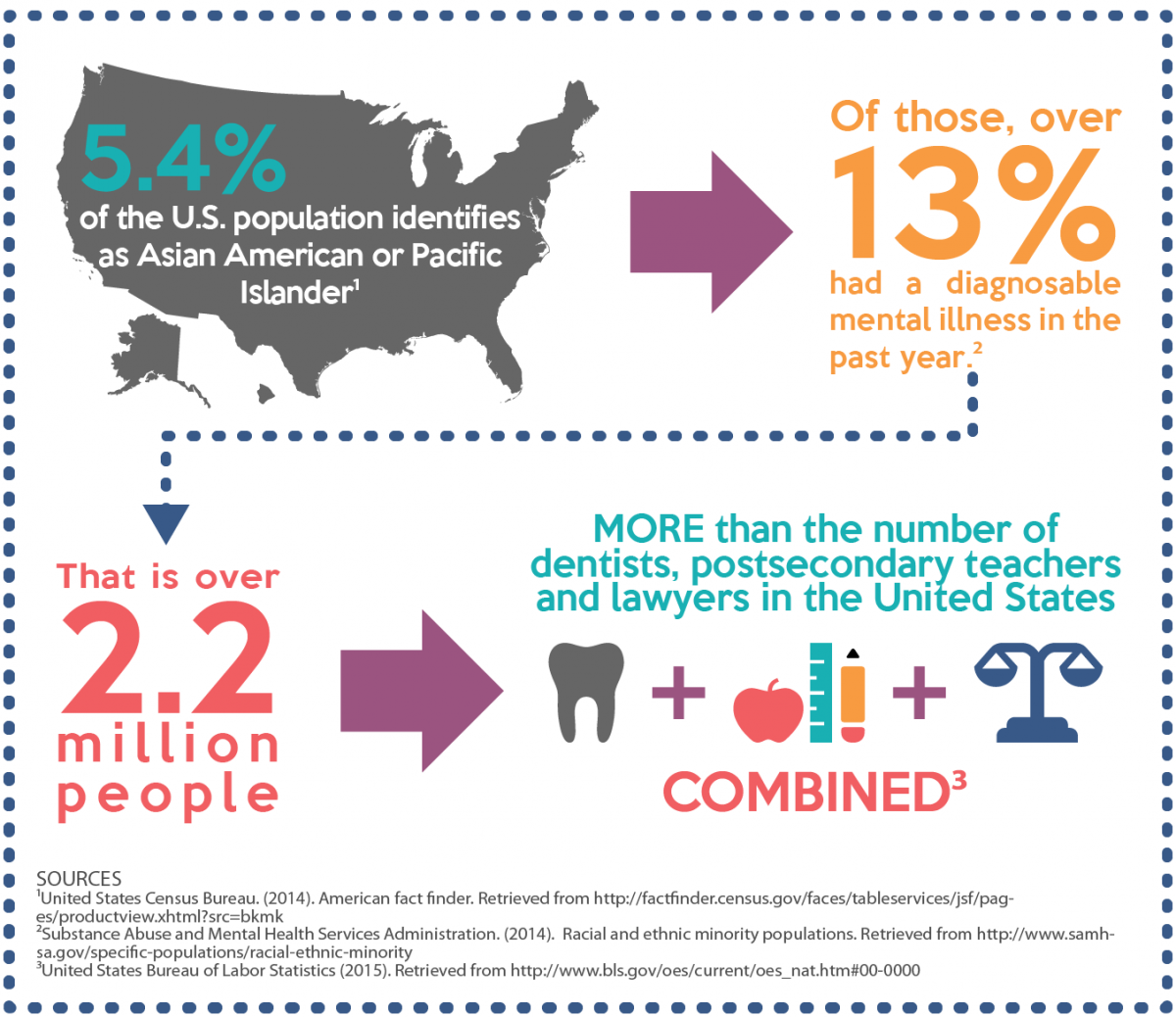You are here
Asian American/Pacific Islander Communities and Mental Health
Mental Health America works nationally and locally to raise awareness about mental health and ensures that those at-risk for mental illnesses and related disorders receive proper, timely and effective treatment. MHA incorporates culturally competent strategies to ensure that it is effectively addressing the treatment and psychosocial needs of consumers and families with diverse values, beliefs, sexual orientations, and backgrounds that vary by race, ethnicity and/or language.

Demographics/Societal Issues
According to the U.S. Census Bureau in 2014 [1]:
- There are 19 million people in the United States who identify as Asian/Pacific Islander, up from 11 million people just fifteen years earlier. 6 million live in California, followed by 1.7 million who live in New York.
- Among Asian Americans, 6.2 million are of Chinese descent, 3.9 million of Filipino descent, and 3.3 million of Indian descent, followed by 1.9 million of Vietnamese descent, 1.8 million of Korean descent, and 1.3 million of Japanese descent.
- In 2012, 13 percent of Asian Americans lived below poverty level, and 15 percent were without health insurance. 21 percent of Pacific Islanders lived below poverty level, and 18 percent were uninsured.
- 51 percent of Asian Americans have at least a Bachelor’s Degree, compared to 29 percent of all Americans, and 15 percent of Pacific Islanders.
- 270,000 Asians are veterans, one-third of them over the age of 65. More than 32,000 Pacific Islanders (including Hawaiians) are also veterans.
- The AA/PI category is extremely diverse, with about 43 different ethnic subgroups who speak more than 100 languages and dialects.
Attitudes
- Knowledge of the mental health needs and attitudes of Asian Americans/Pacific Islanders regarding mental illness is limited. Few epidemiological studies have included Asian Americans or people whose English is limited.
- The National Asian Women’s Health Organization (NAWHO) sponsored a study, Breaking the Silence: A Study of Depression Among Asian American Women, that found:
- Conflicting cultural values are impacting Asian-American women's sense of control over their life decisions
- Feeling responsible, yet unable to meet biased and unrealistic standards set by families and society, contributes to low self-esteem among Asian-American women
- Asian-American women witness depression in their families, but have learned from their Asian cultures to maintain silence on the subject
- Asian-American women fear stigma for themselves, but more so for their families
Prevalence
According to the Centers for Disease Control and Prevention [2], in general Asian Americans report fewer mental health concerns than do whites. However:
- 18.9 percent of Asian American high school students report considering suicide, versus 15.5 percent of whites.
- 10.8 percent of Asian American high school students report having attempted suicide, versus 6.2 percent of whites.
- Asian American high school females are twice as likely (15 percent) to have attempted suicide than males (7 percent).
- Suicide death rates are 30 percent higher for 15-24 year old Asian American females than they are for white females (5.3 versus 4.0).
- Suicide death rates for 65+ year old Asian American females are higher than they are for white females (4.8 to 4.5).
Treatment Issues
- Language barriers make it difficult for Asian Americans to access mental health services. Discussing mental health concerns is considered taboo in many Asian cultures. Because of this, Asian Americans tend to dismiss, deny, or neglect their symptoms. [3]
- Lack of awareness of the resources and services that are available, as well as the stigma surrounding mental health issues, are the biggest deterrents in seeking professional help. [3]
- Most young Asian Americans tend to seek out support from personal networks such as close friends, family members, and religious community members rather than seek professional help for their mental health concerns. [3]
Access/Insurance
Historically, AA/PIs have had challenges in accessing health care and insurance.
- Nearly 1 out of 2 Asian Americans will have difficulty accessing mental health treatment because they do not speak English or cannot find services that meet their language needs. [4]
- Prior to the passage of the Affordable Care Act, 15 percent of Asian Americans, and 18 percent of Pacific Islanders lacked health insurance. [5]
- Relative to other U.S. populations, Asian Americans are 3 times less likely to seek mental health services. [3]
Partnerships and Resources
- Mental Health Screening Resources: http://www.MHAscreening.org
- National Asian Women’s Health Organization http://www.nawho.org/
- National Asian American Pacific Islander Mental Health Association: http://www.naapimha.org/
Sources
[1] United States Census Bureau. (2014). Quick facts. Retrieved from https://www.census.gov/quickfacts/table/PST120215/00
[2] Office of Minority Mental Health. (2016). Retrieved from http://minorityhealth.hhs.gov/templates/content.aspx?ID=6476
[3] Nishi, K. (2016). Mental health among Asian-Americans. Retrieved from http://www.apa.org/pi/oema/resources/ethnicity-health/asian-american/article-mental-health.aspx
[4] Office of the Surgeon General. (2001). Mental health: Culture, race, and ethnicity. Retrieved from http://www.ncbi.nlm.nih.gov/books/NBK44245/
[5] DeNavas-Walt, C., Proctor, B. D., & Smith, J. C. (2011). Income, poverty, and health insurance coverage in the United States: 2010. Retrieved from http://www.census.gov/prod/2011pubs/p60-239.pdf








this page